The Crucial m4 (Micron C400) SSD Review
by Anand Lal Shimpi on March 31, 2011 3:16 AM ESTAnandTech Storage Bench 2011—Light Workload
Our new light workload actually has more write operations than read operations. The split is as follows: 372,630 reads and 459,709 writes. The relatively close read/write ratio does better mimic a typical light workload (although even lighter workloads would be far more read centric).
The I/O breakdown is similar to the heavy workload at small IOs, however you'll notice that there are far fewer large IO transfers:
| AnandTech Storage Bench 2011—Light Workload IO Breakdown | ||||
| IO Size | % of Total | |||
| 4KB | 27% | |||
| 16KB | 8% | |||
| 32KB | 6% | |||
| 64KB | 5% | |||
Despite the reduction in large IOs, over 60% of all operations are perfectly sequential. Average queue depth is a lighter 2.2029 IOs.
Our light workload actually does a lot better on the m4. The m4 is virtually tied with Intel's SSD 510 as the second fastest drive we've tested thus far over a 6Gbps interface:
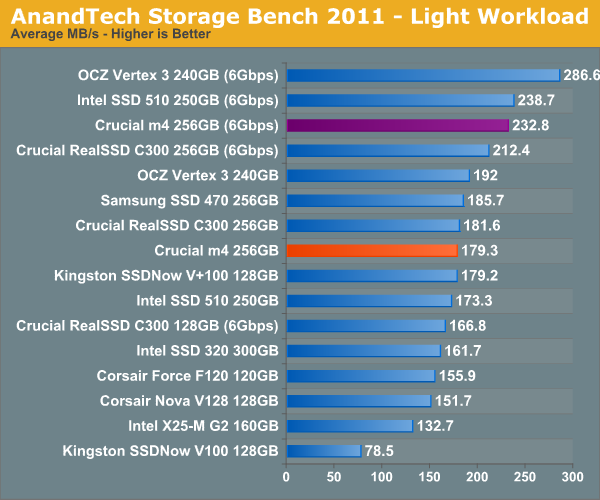
Over a 3Gbps interface the m4 is actually no faster than the old C300.
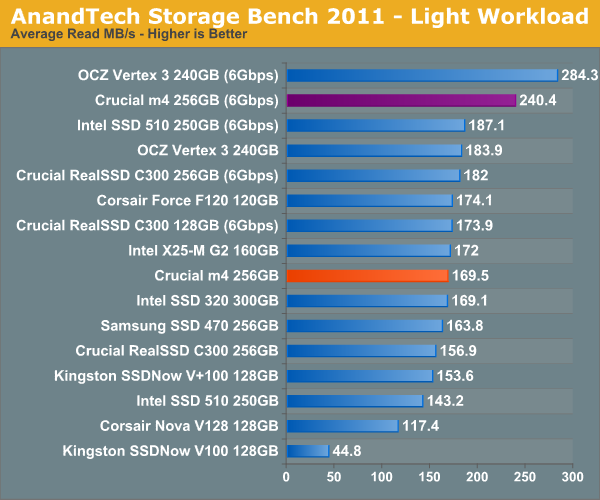
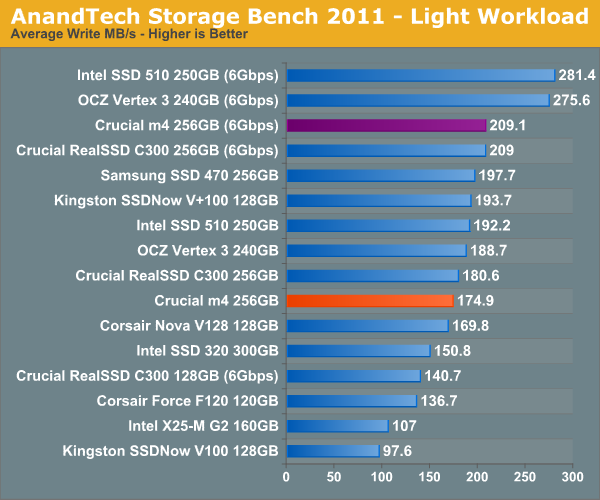
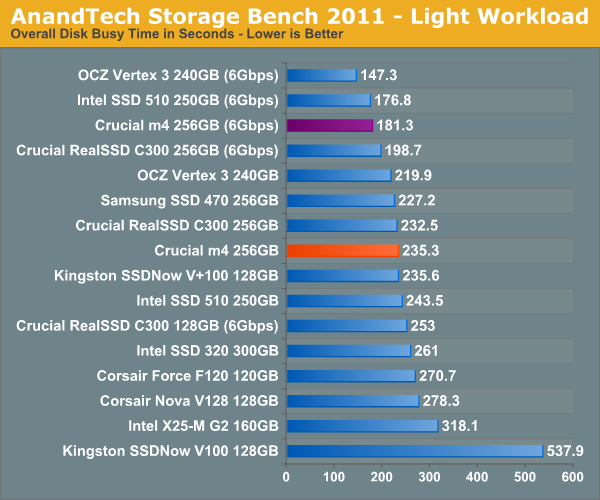
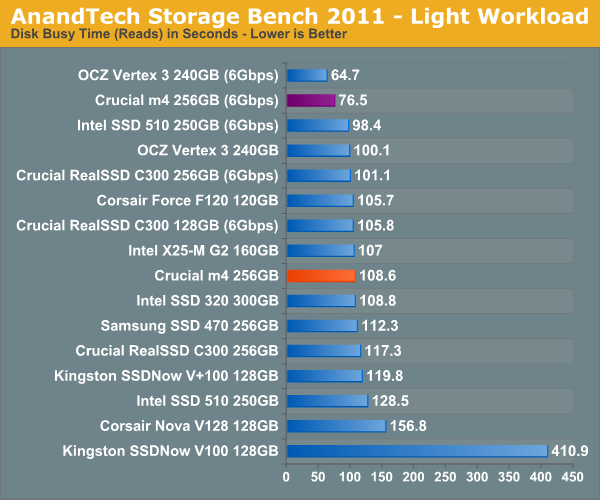











103 Comments
View All Comments
JNo - Thursday, March 31, 2011 - link
On another note, now that my system drive is an 80GB Intel X25M SSD, I really notice how my Documents folders that all have to be on mechanical HDDs due to their size, are very unresponsive. In fact often Win 7 hangs for about 10-15 secs just trying to open my Documents or Video folder when nothing else is going on! (This on a Core2 Q6600 so not a netbook or anything).Whilst I'm sure I would benefit from a 6Gbs controller and a Vertex 3 or m4, I wonder if the smart money in future will go on getting one or two cheap(er!) 40GB SSDs to act as cache drives for my couple of larger (1 - 2 TB) media and Documents drives. The figures on Tomshardware on Z68 caching performance were not awe inspiring but definitely a great option to have...
james.jwb - Thursday, March 31, 2011 - link
The HDD is probably going into sleep mode. Happens to mine all the time with an SSD. I hear it spin up as my PC is silent apart from the HDD. Could always turn it off or prolong it kicking in.strikeback03 - Thursday, March 31, 2011 - link
Seconded, I hear the same thing on my Win7 desktop with an 80GB X25M G2 and 3 mechanical HDDs. The HDDs go to sleep after 15-30 min, and take several seconds to spin back up when data is needed. It isn't enough of a bother to me to change the sleep time, but it can be done if necessary.softdrinkviking - Thursday, March 31, 2011 - link
Anand,you've already seen the results of the new samsung drive, and the new corsair, and who knows how many other SSDs are currently being pu tthrough the paces in your lab.
those drives that are still officially unknown paint a more complete picture of the industry and the future of SSDs.
how much would you say your reviews reflect that bigger picture?
are we to assume that you are giving us your opinion of this drive from our perspective, or yours?
I know that can be a hard balance to strike in writing, between the prescient and the contemporaneous, and I can't help but wonder.
Anand Lal Shimpi - Thursday, March 31, 2011 - link
I'd say the majority of what you see here is reflecting the bigger picture. The Corsair P3 is nice but it seems to fall behind Intel's 510. The Samsung 470 is a great 3Gbps offering but it's a bit pricey. I still have some additional testing to do on both of those, which I expect to be done (realistically) next week.Take care,
Anand
Lonesloane - Thursday, March 31, 2011 - link
I'm really missing "real world benchmarks", such as loading times. These synthetical benchmarks mean nothing to me.In general it seems as Sandforce will be the big winner of the SSD market in 2011.
Anand Lal Shimpi - Thursday, March 31, 2011 - link
Load times for a single application are pretty much consistant through all of the modern SSDs. It's really in the heavy workload scenarios or periods of burst activity that you'll see differences. Note that our own storage bench suite plays back real world IO tasks that encompass exactly what you're looking for :)Take care,
Anand
sticks435 - Thursday, March 31, 2011 - link
One thing I'd like to see is the Vantage scores on a Sandy Bridge platform. Since most other sites use it as their real world benchmark, and they/most users will probably be using these new drives with a SB system, it makes it a little easier to compare numbers. Yes, I know comparing from site to site is usually a crap shoot, but would still be a nice to have. Perhaps when PC Mark 7 is available.shatteredx - Thursday, March 31, 2011 - link
For many of us, SSD performance has reached the "good enough" milestone. The "big winner" of the SSD in market in 2011 will be whoever is willing to price these things the cheapest combined with typical customer feedback that the drives are reliable.Anand's prediction that we'll have to wait until 2014 for prices to drop under $1/GB is not comforting.
geniekid - Thursday, March 31, 2011 - link
++. In fact, I thought SSDs were good enough two years ago. Give me one of these new SSDs with HALF the performance and twice the storage size at the same price and I'll take it.